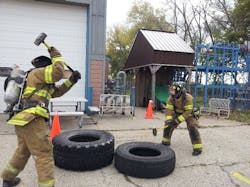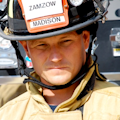Health & Wellness: Creating a Fire-Rescue Workout Program
You and your crew are called to a multi-unit, balloon-frame structure fire as the second-due engine company. When you arrive on scene, you see fire venting from the windows on multiple sides. Your first task is to grab the 2½-inch hoseline and hit the fire from the exterior of the building. The cold weather conditions make it difficult to maneuver the heavy line, but you and your crew manage (somehow) to gain control of the fire. Attack is now moving interior for mop-up and overhaul, so your crew now takes a 1¾-inch hoseline to the third floor. The slippery conditions and massive amounts of plaster and debris on the floor make it difficult. You and your crew work interior fire operations for 40 minutes, you go through two bottle changes, and finally have the fire and hot spots completely extinguished.
Regardless of whether you are working on a career or volunteer department, this is a common fire response that can happen in any city, township or village. The question you should ask yourself as you read this scenario is “Am I ready for a call like this?” In other words, are you mentally and physically ready to handle the demands?
Stop working out
Before I became a firefighter, I was a trainer in both large and small health clubs. During that time, I saw a lot of people exercising consistently and with intensity but only making a limited amount of fitness progress. Why? Because we are all creatures of habit in the gym and out. These “snail-paced progress” gym-goers were all doing the same thing—working out, not training. And yes, there is a difference. A workout is performed for the purpose of producing a stress that satisfies the immediate needs of the exerciser—to burn some calories, “blow off steam,” relieve mental stress, pump up the biceps, etc. A lot of people in gyms and firehouses do this every day. There isn’t anything wrong with this per se, but it is a very “short-sided” approach to fitness.
Start training
When I was working with athletes (both professional and amateur), we weren’t just exercising; we had a definitive performance or training objective. For athletes, including firefighters and medics, training is a necessity—or at least should be. Training is a physical activity performed for the purpose of satisfying a long-term performance goal. Training involves a 360-degree approach to fitness, where one workout builds on the next, all leading to a long-term goal. Athletes try to get bigger, stronger, leaner, faster and use a well-planned training workout program to achieve these goals. As a fire-rescue athlete, you need to approach your fitness like an athlete and therefore think about how you can improve your performance on the fire and rescue scene.
Program essentials
Firefighters need to be strong, have good muscular endurance and great core and grip strength, and must be able to recover quickly. The challenge that we face is finding a workout program that can efficiently and effectively meet all of our physical demands.
What is the best workout for firefighters, EMTs and paramedics? There is no single perfect program for all fire-rescue athletes. There are, however, some essential elements that must be considered when evaluating and creating an effective workout program.
#1: Periodization and principles of science—Training should follow a developmental approach or progression. This means that there should be a hierarchy of training. First, it is essential to develop a training base that increases the body’s functional capacity. Once this is accomplished, the intensity of the exercise is increased to emphasize strength and muscular development. In more general terms, the program must develop stability, then strength, and finally power. Regardless of what the training program looks like, it cannot violate this developmental approach.
#2: Cardiovascular conditioning and recovery—The leading cause of duty-related fatalities among firefighters is cardiovascular disease. In fact, sudden cardiac death has consistently accounted for approximately 45 percent of all on-duty firefighting deaths in the United States since at least the 1970s. These statistics indicate the importance of cardiovascular health for firefighters, meaning focusing on more than the traditional cardiovascular conditioning of running or biking. Firefighters must have a good level of aerobic fitness, but they cannot overlook the value of challenging the anaerobic systems. If you’ve ever humped a charged hoseline up some stairs or dragged a victim or axed a roof open, you probably realize the importance of anaerobic fitness. An effective fitness program will set a good cardiovascular base, then challenge the cardiovascular system with intervals. Intervals are one of the best ways to simulate the high level of fitness required on the fireground.
#3: Core strength and balance—The IAFF annual Death and Injury Survey reveals that sprains and strains routinely account for approximately 50 percent of all line-of-duty injuries, and back injuries account for approximately 50 percent of all line-of-duty injury retirements each year. These injuries may result in significant lost time and medical expense. To limit or prevent these injuries, a workout program must utilize exercises that focus on the developing the glutes, shoulder girdle, hamstrings, hips and abs. (Notice that I didn't say anything about a "six pack" of abs.)
#4: Functional exercises and “specificity”—Specificity is the principle of training that states what you do in the gym should be relevant and appropriate to your desired outcome. In other words, you must integrate movements that will improve efficiency on the fire and rescue scene. Functional strength exercises like deadlifts, squat press, crawls, sledges, drags and carries increase balance around the joints, help prevent injuries, and promote efficient movement patterns by stimulating stabilizing muscles.
#5: Active warm-up and flexibility training—Flexibility is often the most overlooked aspect of an effective firefighter workout program. Participating in an appropriate warm-up, cool down and stretching program has shown to help firefighter performance by increasing physical efficiency and performance, increasing neuromuscular coordination, decreasing risk of injury, and decreasing stress and tension.
#6: Planned rest periods and recovery activities—You must take time to recover. I know that many firefighters, EMTs and paramedics like to challenge themselves and may have a tendency to push their physical limits. Taking the time to rest between strength workouts (or after a tough shift) is imperative to the body. Recovery encourages the repair process, increasing lean muscle and making you stronger and able to do more come the next workout. Activities like foam rolling and yoga are great tools to accelerate the recovery process by increasing circulation to tired muscles. Programs that don’t emphasize rest and recovery lead to diminished fitness results and possible injury.
These elements are essential to a solid workout program. Not giving attention to these principles can lead to less-than-desirable training outcomes and even injury.
In sum
This is just the tip of the iceberg when it comes to creating an effective fire-rescue workout. I hope this information does impress on you the importance of having a plan and incorporating the proper elements. This is not an all-encompassing list, but it will give you enough information to help evaluate and create an effective workout program. Does your current program have these elements? If not, make adjustments and watch your performance improve.
References
Occupational Medicine. (n.d.). Retrieved from https://occmed.oxfordjournals.org/content/64/4/228.full#ref-1
Back Injury Statistics: Retrieved from http://www.iaff.org/hs/resi/backpain.asp
About the Author
Aaron Zamzow
Aaron Zamzow is a firefighter/training officer for Madison, WI, Fire Department. He holds a bachelor’s degree in health/wellness and has 20 years of experience as a fitness trainer. He created Fire Rescue Fitness and authors programs that are aimed at getting fire rescue athletes fit for duty.

